

In almost any walk of life, it is wise to take help anywhere you can get it. If it’s certified, or better yet degreed or licensed, all the better.
That brings us to one of the more interesting wrinkles in the new version of what is believe to be the largest annual U.S. nursing home salary and benefits survey.
The “Nursing Home Salary & Benefits” report from the Hospital and Healthcare Compensation Service included the job title “nurse practitioner” for the first time in its 42-year history when it was released Monday. Good move.
Healthcare providers everywhere are looking for lower-cost ways to provide good care, and skilled nursing operators are certainly no exception. So the addition makes a lot of sense. Also with the Patient-Drive Payment System moving the needle more toward the clinical side of the meter, people with medical chops are going to enjoy more of the spotlight in long-term care.
One expert says that improving relations with the medical director is one of the most important priorities in preparing for PDPM’s October 1 rollout. That’s notion’s been seconded in a variety of ways in the accelerating preparation for the biggest change in nursing home payment systems in at least a generation.
It would only stand to reason that nurse practitioners, and physician assistants, would rise in prominence and use.
To review, a nurse practitioner is an advanced practice registered nurse classified as a mid-level practitioner who is trained to assess patient needs, order and interpret diagnostic and laboratory tests, diagnose illness and disease, prescribe medication and formulate treatment plans.
Physician assistants are medical providers licensed to treat illness and disease and to prescribe medication for patients. They work directly in collaboration with physician offices, hospitals and clinics.
In brief, NPs follow more of a patient-centered model while PAs focus more on a disease-centered model.
So the addition of nurse practitioners meshes perfectly with the rise of PDPM — the program that one stakeholder previously described as putting the “nursing” back in nursing homes. On a related note, the effects of heavier clinical overtones have already been noticed. Close observers have recognized more frequent use of nursing home “patients,” as opposed to “residents,” since PDPM has entered the vernacular.
HCS Director of Reports Rosanne Zabka said the addition of nurse practitioner came at the request of providers themselves. Only 70 respondents, 66 of them in the 110+ beds category, indicated they had one or more on staff in this report. But that number is expected to rise.
The average hourly wage for a nurse practitioner rang in at $53.89. That denoted the 50th percentile, which was bracketed by $49.84 and $58.38 in the 25th and 75th percentiles, respectively. The national average at continuing care retirement communities responding in this survey was $51.74.
Nurse Practitioner replaces Household Coordinator (which also was proposed by participants years ago but “tanked” recently).
“There is a growing demand for NP and PA data in all of healthcare, so we feel that participation for NPs will definitely increase,” Zabka told me Tuesday.
She confirmed my theory for their rise.
“As with clinics, or even our Family Practice physician, providers are using NPs as a more cost-effective alternative to physicians,” she explained. “NPs are not replacing physicians or medical directors, but are being used on less complex cases, or as a screening for the physician follow-up.”
NPs are similar to the “hospitalist” title in acute care, Zabka added: “Years back, hospitalists became the new norm as hospitals hired ‘jack-of-all trade’ physicians, versus a physician for each specialty type.”
It’s nice to see one of the premier resources for gauging skilled nursing professionals’ compensation and benefits levels continue to change — much the way the caregiving process is evolving itself.
Follow Executive Editor James M. Berklan @JimBerklan.




